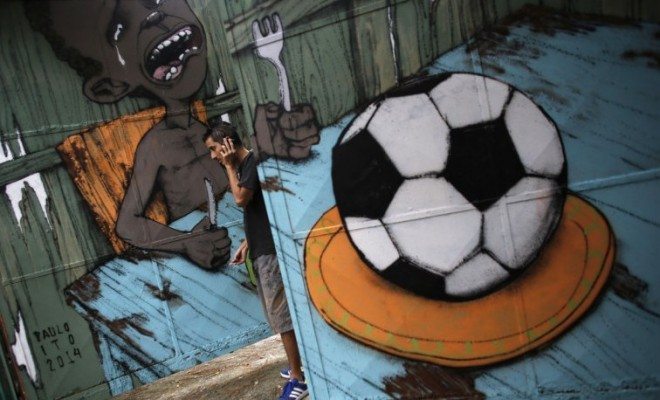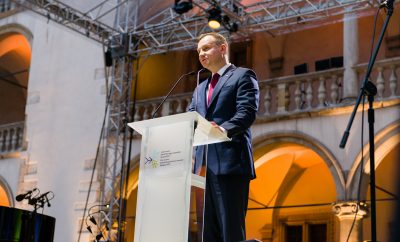
Society and Culture
World Cup Brazil: ‘Let Them Eat Football!’
“According to the mural, soccer is the opium of the masses, the bread and circuses of today’s Brazil: let them eat football!”
-The Guardian
On Thursday, June 12, 2014 police clad in riot gear and wielding clubs fired tear gas, rubber bullets, and noise bombs into crowds of protesters in São Paulo, about 10 km away from the Corinthians arena where the first game of the 2014 FIFA World Cup took place. Six people were injured, and three protesters arrested. This is only a sample of the protests surrounding the soccer tournament over the past year. Brazilian President Dilma Rousseff, the country’s first female leader of the so-called Workers’ Party, has subsequently deployed 100,000 police and 57,000 military to guard stadiums, teams’ hotels, and training grounds for the duration of the World Cup.
Such incendiary scenes of social protest in Brazil might conjure images of France in 1789 at the eve of revolution. Parallels abound: the people demand basic services in a grossly unequal society, and their government responds flippantly with gestures of added luxury for the wealthy; ‘Let them Eat Football.’ Brazil hosts the FIFA World Cup at an estimated cost of $11.5 billion in preparations, dolled out from public coffers, not to mention the lives of eight workers who died while constructing grandiose stadiums across the country. The expenditures for the most expensive World Cup in history are well documented (here, here and here) as are the nefarious practices of FIFA (here and here); an additional $12 billion is being spent on projects to host the 2016 Summer Olympics in Rio De Janeiro. Meanwhile, the Brazilian people lack basic healthcare services, affordable public transportation and education, adequate housing and security, while suffering from trenchant institutionalized racial and economic discrimination.
According to President Rousseff, anti-FIFA demonstrations across the county are part of a “systemic campaign” against the Brazilian government, yet protesters do not see their plight as one isolated to the country. “The crisis is worldwide,” an anonymous member of the Brazilian anarchist Black Bloc group told the Global Post. “People are seeing that representative democracy doesn’t represent anyone — here in Brazil, in London, in Greece or anywhere.” And political graffiti is the undercurrent of this global cacophony of dissent.
Graffiti that reads “FIFA go home” or “Fuck the World Cup” have appeared on walls from São Paul to Rio De Janeiro, distilling the disdain of the Brazilian people into iconic slogans that they repeat during protests. Murals that celebrate the World Cup have been vandalized; a mural in Rio de Janeiro depicting Neymar da Silva Santos was painted over so the figure wore a hood used iconically by the anarchist Black Bloc. The most pervasive political graffiti, however, are murals that explicitly illustrate the concerns of protesters: One piece by Brazilian artist Cranio depicts a man flushing money down the toilet bowl; in another, the 2014 World Cup mascot points a rifle at a message that reads, ‘We Want Education’ and ‘Not Repression’. Protests iterated at demonstrations physically are thus represented on walls throughout the country.
“People already have the feeling and that image condensed this feeling,” São Paulo-based graffiti artist Paulo Ito told Slate in May when photos of his mural in Rio de Janeiro began circulating through social media. The piece shows a weeping, emaciated Brazilian boy, fork and knife in hand, being served a football on a silver plate. “The message of this painting is powerful,” the Guardian interpreted. “Amid the sporting hysteria, poverty not only goes on, but the lives of the marginalized have arguably been made worse.” The image has since gone viral accumulating 3,310 likes and 4,749 shares on Ito’s Facebook account alone; on the popular Facebook page TV Revolta it has been shared and liked more than 40,000 times. Graffiti is a “good way to expose the country’s problems,” Paulo Ito explained. “If the government doesn’t want to expose these things it’s because they feel ashamed. If they feel ashamed by this they might take it more seriously – at least, that’s our intention.”
Artists B. Shanti and A. Signl of Captain Broderline, an international graffiti collective that was outlawed in Egypt last year, share this aim, producing their own political art in Brazil. “We just want to support the people on the street and give them like a voice that when all the people come here and look at the nice World Cup they also see the resistance movement.” Their mural, organized with Amnesty International Brazil, stands across from a police headquarters in Rio de Janeiro, displaying construction shovels attached to a giant soccer ball demolishing favelas along a regal red carpet — it is dedicated to all Brazilians evicted during the preparations of the World Cup.
But can such graffiti be harbingers of revolution? “Look at these images from far enough back – from the point of view of world television, with its cameras aimed at the football pitch – and they become a sideshow to the spectacle in the stadiums,” said Jonathon Jones in the Guardian. “But perhaps this is one of those moments when the images break open, the dreams and nightmares of society spill from fantasy into reality, and the hungry kid gets fed. In that case, these paintings will become icons of a revolution started by sport. It is, however, more likely they are simply adding a bit of a sting to the usual, overfamiliar opiate.” In the case of Brazil, we cannot hold up graffiti’s illegality as an indication of its political effectiveness. Graffiti has been legal in Rio de Janeiro since 2009, when the Brazilian government passed Law 706/07; today, artists can mark public buildings, including columns, walls, and construction siding, as well as private property if done with the consent of the owners. As compared to Egypt, where the government has banned political graffiti, Brazil has a relatively liberal policy regarding street art, and why not? — public art has been statistically proven to increase the value of real estate.
There is, however, definite political meaning in the graffiti critiquing the government and the World Cup; and what is more significant, in my opinion, is the solidarity that this graffiti has given to the disparate protests in Brazil. All voices rally behind the slogans echoed by the graffiti in the street — eg, “FIFA go home.” The inclusion of international graffiti collectives like Captain Borderline, moreover, aligns Brazilian dissidents with those around the world. Allusions to the French Revolution are not overstated. “When people go on the street and create pressure they become political actors,” said an anonymous Brazilian anarchist, this “new generation is very radical.” And graffiti plays a fundamental role in making it so.
—
Ryan D. Purcell (@RyanDPurcell) holds an MA in American History from Rutgers University where he explored the intersection between hip hop graffiti writers and art collectives on the Lower East Side. His research is based on experience working with the Newark Public Arts Project and from tagging independently throughout New Jersey and New York.
Featured image courtesy of [Jordi Bernabeu Farrus via Flickr]








Comments